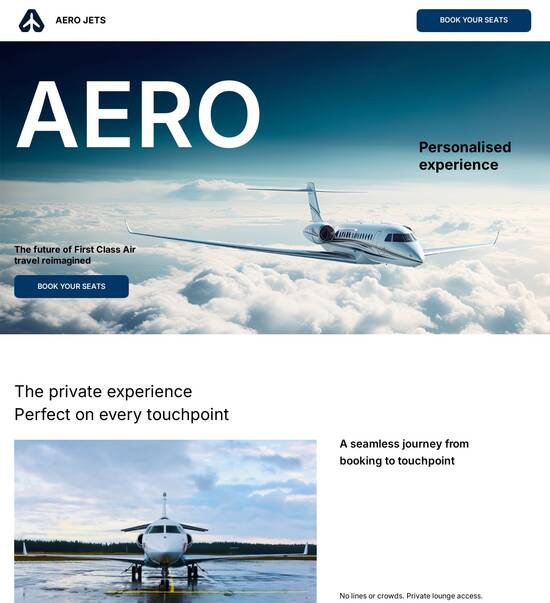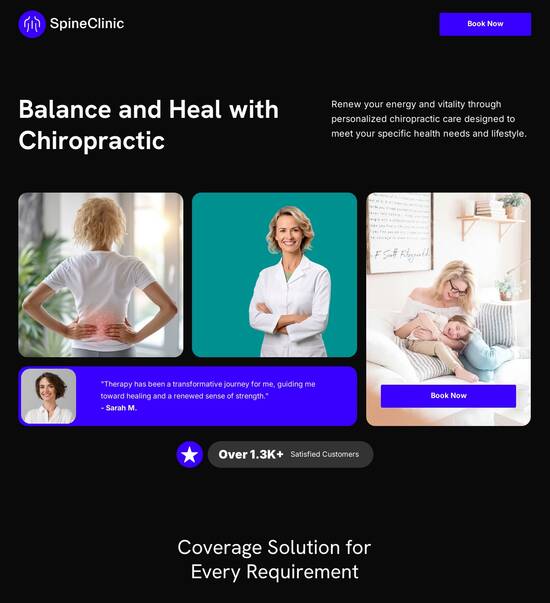
PWA onboarding page templates
Use TemplateAbout template
Use PWA onboarding page templates and stay true to your brand identity. Resonate with your audience today.
Recommended templates

Easy to build without coding
With the intuitive drag-and-drop builder, anyone on your team can create high-converting pages without any knowledge of code or design. Make enhancements to your landing page with custom widgets using Javascript, HTML/CSS, or third-party scripts.

Multiple layouts for any industry and goal
Select from 500+ landing page layouts built to boost conversions across industry-specific scenarios. Customize them by adjusting fonts, adding images, and generating on-brand content with the AI assistant. Quickly scale with Instablocks® and Global Blocks that you can save, reuse, and update globally.

Loads fast and looks polished on any device
Every template is responsive, which means they present professionally on any device and load blazingly fast with our Thor Render Engine. You can also power them up with Google AMP technology to deliver an unparalleled mobile experience and drive higher conversions.

Robust analytics & experimentation
Get real-time updates and reporting across all your devices, showing the number of visitors, conversions, cost-per-visitor, and cost-per-lead. Launch AI-powered experiments, run A/B tests, and use heatmaps to analyze user behavior, then optimize your landing page to maximize conversions.







Easy to build without coding
With the intuitive drag-and-drop builder, anyone on your team can create high-converting pages without any knowledge of code or design. Make enhancements to your landing page with custom widgets using Javascript, HTML/CSS, or third-party scripts.
Multiple layouts for any industry and goal
Select from 500+ landing page layouts built to boost conversions across industry-specific scenarios. Customize them by adjusting fonts, adding images, and generating on-brand content with the AI assistant. Quickly scale with Instablocks® and Global Blocks that you can save, reuse, and update globally.
Loads fast and looks polished on any device
Every template is responsive, which means they present professionally on any device and load blazingly fast with our Thor Render Engine.
Robust analytics & experimentation
Get real-time updates and reporting across all your devices, showing the number of visitors, conversions, cost-per-visitor, and cost-per-lead. Launch AI-powered experiments, run A/B tests, and use heatmaps to analyze user behavior, then optimize your landing page to maximize conversions.
All the features you need to build lead-generating landing pages
Explore more featuresLearn how to build top-performing landing pages for any goal
FAQs
Leading the way in building high-performing landing pages





Mastering Landing Pages with Instapage: The Ultimate Guide
Landing pages are essential for maximizing the effectiveness of your digital marketing efforts. For marketers across various sectors including business services, tech, and education, leveraging Instapage as a powerful landing page and conversion rate optimization (CRO) platform is key to accelerating their campaigns. This guide will walk you through the process of creating high-converting landing pages that yield tangible results, while also addressing common queries related to this innovative tool.
Understanding What Makes Instapage Unique
Instapage stands out as a flexible and user-friendly platform offering over 100 high-converting templates and lead generation elements. With its intuitive builders, marketers can launch effective landing pages with no coding required, ensuring that you can focus on creative strategies rather than technical hurdles. Not only does this facilitate quicker time-to-market, but it significantly enhances your ability to test and iterate campaigns efficiently.
- Dynamic and adaptable templates: Choose from a library of conversion-focused landing page layouts tailored for various campaign needs.
- Streamlined lead generation: Utilize pre-built lead gen elements to enhance your ability to capture potential clients seamlessly.
- No developer needed: Focus less on technicalities and more on creative solutions by utilizing the user-friendly page creation process offered by Instapage.
Step 1: Designing Your Landing Page with Templates
Leverage Instapage’s extensive library of templates to kickstart your landing page design. Start by selecting a template that aligns with your marketing goals. Customize the elements as needed to reflect your brand’s identity and target audience, ensuring each component resonates with your marketing message.
Step 2: Optimizing for Conversions
Once your design is set, utilize Instapage’s optimization tools to enhance conversion rates. Focus on A/B testing various elements such as headlines, images, and calls to action to identify what resonates most with your audience.
- Conduct A/B Tests: Experiment with different variations of your landing page to identify which design and content yield the best conversion rates.
- Utilize Heatmaps: Analyze on-page behavior using heatmaps to understand user interaction and discover any areas that may cause drop-offs.
- Incorporate Feedback: Use customer feedback and performance insights to continually refine and iterate on your landing page for better results.
Step 3: Personalizing User Experience
Personalization is crucial to engaging your audience meaningfully. Use Instapage’s dynamic text replacement and AdMaps to create experiences tailored specifically to different customer segments, ensuring that your campaigns resonate with the right audience.
- Dynamic Text Replacement: Enhance engagement by dynamically changing text on your landing pages based on user behavior or context.
- Targeted Ads: Use AdMaps to connect specific ads with corresponding landing pages, increasing relevance and conversion likelihood.
- Audience-Level Tracking: Monitor performance at the audience level to adapt your strategies based on actual user data and interactions.
By systematically applying these steps, marketers can maximize their campaign effectiveness through optimized landing pages while enjoying seamless collaboration and fast-paced results.
Ready to elevate your digital marketing strategy? Start using Instapage today to design, optimize, and personalize your campaigns for maximum ROI!
Unveiling the PWA Onboarding Page Template: A New Horizon in User Engagement
The essence of PWA onboarding
Progressive Web Apps (PWAs) combine the best of web and mobile apps to deliver a seamless user experience. PWAs are built using standard web technologies, ensuring they can be accessed via any device with a web browser. Key characteristics include offline functionality, push notifications, and the ability to be installed on the user's device, resembling a native application. This adaptability enhances user engagement significantly.
Onboarding is a critical phase in the user journey, especially for PWAs. An effective onboarding process can greatly impact user retention and satisfaction. Users who understand how to navigate an application easily are far more likely to return. The onboarding page, therefore, serves as a gateway to user engagement, providing essential information and guidance right from the start.
Designing the perfect onboarding page: Fundamentals
User-centric design is foundational when creating effective onboarding pages. It's crucial to prioritize user experience by simplifying layouts and navigation. Keeping the interface intuitive and avoiding overwhelming users with information can significantly enhance their initial experiences. Users should feel guided rather than lost when exploring new functionalities.
Incorporating visual hierarchy and ensuring accessibility play vital roles in designing onboarding pages. Clear distinctions between elements, such as buttons and headings, create a logical flow that directs users' attention. An accessible onboarding page should cater to all users, including those with disabilities, ensuring everyone feels included and supported.
Features of PWA onboarding page templates
PWA onboarding page templates come equipped with several pre-configured project templates that fit various app categories. These templates can serve as a solid starting point, allowing developers to customize them based on specific needs. Having a ready-made layout saves time while also maintaining a professional appearance.
Moreover, customizable assets allow businesses to reflect their brand identity effectively. Users can change colors, fonts, and imagery to align with company standards, creating a cohesive experience. To ensure smooth user experiences, templates should also easily integrate with existing web app onboarding tools, streamlining the entire process.
Benefits of using onboarding page templates
Utilizing onboarding page templates comes with myriad benefits for businesses. First and foremost, they significantly improve time efficiency. By leveraging pre-designed structures, marketers and developers can launch onboarding pages more quickly, allowing more focus on optimizing other areas of user engagement.
Secondly, templates promote consistency across platforms. A unified look and feel enhances user trust while maintaining the same messaging throughout different app environments. Finally, onboarding page templates enhance user guidance by systematically walking users through app features, building confidence and familiarity with the application.
Categorizing your onboarding experience
Understanding and segmenting users is pivotal for crafting personalized onboarding experiences. Different user demographics have unique needs, and tailoring onboarding processes based on these insights optimizes individual user experiences. For instance, new users may require more comprehensive guidance than returning users.
New users – those unfamiliar with the application should receive step-by-step instructions.
Returning users – quick refreshers can be provided to reorient them with new features.
Experienced users – compatibility setups can be minimized to allow them immediate access to advanced features.
Implementing a tagging system can greatly enhance the organization of onboarding efforts. Tagging projects based on user needs, functionality, or demographics allows teams to better manage resources and respond quickly to updates or changes.
Essential design resources for onboarding pages
Choosing the right design resources can enhance the onboarding experience significantly. Graphic design tools, such as Canva or Adobe XD, provide a platform for creating visually appealing content. These tools help in crafting unique graphics that align well with the overall design of the onboarding page.
Additionally, resource libraries serve as excellent repositories for assets like icons, images, and layouts. Websites like Unsplash and Icons8 offer a range of free and premium resources specifically tailored for onboarding pages. Alongside this, selecting the right typography and color schemes is vital; choosing fonts that are readable and colors that reflect the brand enhances user engagement and aesthetic appeal.
Navigating legalities: Terms and privacy policy considerations
As with any aspect of user engagement, legalities should never be overlooked. Incorporating clear user agreements on onboarding pages is essential to explain how information is used and protected. By explaining these terms upfront, businesses can foster trust and build transparency.
Best practices dictate that terms and privacy policies should be easily accessible during onboarding. User comprehension can be ensured through straightforward language and concise summaries that outline user rights alongside an explanation of personal data handling.
Accessing template libraries: Discovering thousands of options
To find the best onboarding page templates, several platforms offer extensive libraries. Websites like Instapage specialize in providing a diverse array of templates, tailored for different needs and industries. The key is to select templates that resonate with your brand’s identity while also catering to target users.
Before making a selection, it’s important to evaluate template quality. Factors to consider include usability, customization options, and customer reviews. This ensures that the templates not only look good but also function effectively in meeting user needs.
Implementing feedback mechanisms in onboarding pages
Gathering user feedback is crucial in assessing onboarding effectiveness. Integrating user survey tools during or after the onboarding process can provide valuable insights regarding user satisfaction. It offers users a voice in highlighting areas for improvement, ensuring ongoing refinements.
A/B testing can further optimize onboarding experiences by testing different approaches and identifying what resonates best with users. Tracking user interactions during these tests helps you understand preferences and can guide future enhancements.
The future of onboarding in progressive web apps
As user engagement evolves, so too will onboarding strategies. Emerging trends indicate a move towards innovative onboarding experiences that are not only engaging but also personalized. Keeping abreast of user behavior and technological advancements will be key to staying ahead.
Artificial intelligence has the potential to revolutionize onboarding by enabling even greater personalization. By analyzing user data, AI can suggest tailored features, recommend content, or streamline navigation to fit individual user profiles, enhancing overall experience.
Engaging with PWA onboarding: A path to success
Advanced analytics can provide insights into user interactions, allowing businesses to refine their onboarding processes continually. Understanding data such as drop-off rates or feature usage can inform necessary adjustments to improve onboarding efficiency.
Encouraging community-driven discussions about template efficacy can lead to valuable insights. Engaging with developers and designers for feedback can enrich the resources available and aid in the continual enhancement of onboarding experiences.
Ready to skyrocket conversions?
Supercharge your ad campaigns with high-performing landing pages
Get started














